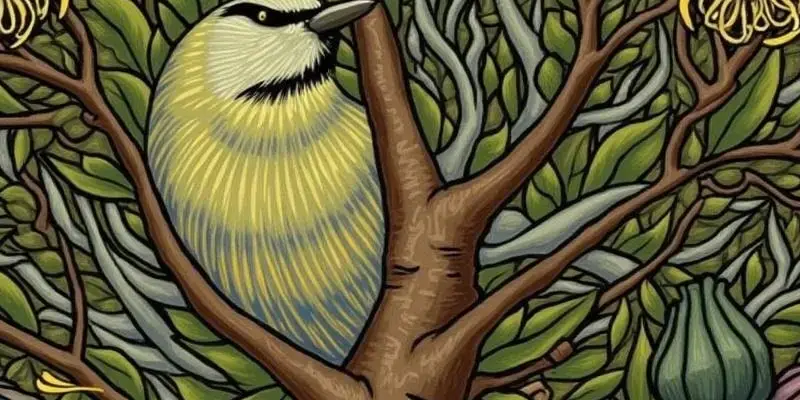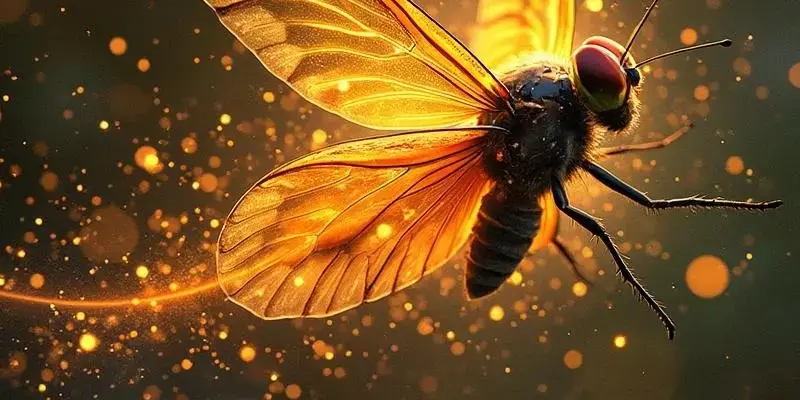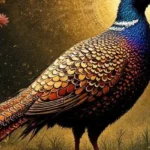Bowerbird spiritual meaning

The bowerbird, particularly the Satin Bowerbird with its striking blue-black plumage and violet eyes, holds profound spiritual significance as one of Australia’s most mystical birds. These remarkable creatures, known as “ngurum-bula” or “two homes” in Wiradguri tradition, demonstrate extraordinary dedication by spending six months constructing elaborate bowers—architectural masterpieces that serve as physical manifestations of their creative spirit.
Key Takeaways
- Bowerbirds create elaborate structures that symbolize creative expression and spiritual dedication
- Their collection of predominantly blue objects represents an innate appreciation for beauty and intentional selection
- The distinct separation of male and female roles teaches lessons of independence and self-reliance
- Indigenous cultures have observed and integrated bowerbird wisdom into their spiritual teachings for over 65,000 years
- Adopting bowerbird principles can lead to enhanced creativity and mindfulness in everyday life
The Architect of Spiritual Expression
The male bowerbird stands as a master architect in the animal kingdom, creating structures that transcend mere functionality. These bowers, reaching up to one meter in length, showcase remarkable engineering skills and artistic vision. Using sticks joined with a natural adhesive made from vegetable matter and saliva, these birds create either A-frame designs or avenue structures with astonishing precision.
During breeding season, males devote 7-8 hours daily to perfecting their creations. This dedication isn’t merely about shelter—it’s their primary method of attracting mates. Unlike many other species where physical attributes determine mating success, the bowerbird’s romantic prospects depend almost entirely on the quality of his bower. The most successful builders can mate with more than 20 females in a season, achieving success rates of 70-80%, while less skilled architects might not mate at all.
The Sacred Art of Beauty Collection
The Satin Bowerbird displays an almost spiritual reverence for beauty, particularly favoring blue objects that make up about 70% of their collections. This preference exists despite blue items being relatively uncommon in their natural environment, suggesting an intentional seeking of beauty rather than random gathering. The bird’s collection habit mirrors what many spiritual traditions consider mindful appreciation—finding and honoring beauty in the world.
What makes this behavior even more fascinating is the methodical arrangement of these treasures. Bowerbirds organize their collected items with careful consideration for size, color, and type. Studies show that approximately 78% of collected objects appear to have personal significance to the individual bird. Some bowerbirds have even been documented stealing specific blue items from human properties, showing discernment similar to magpies’ attraction to shiny objects.
This collecting behavior teaches us about the spiritual importance of surrounding ourselves with beauty that resonates with our inner nature. The bowerbird doesn’t collect randomly—it curates its environment with intention, creating a sacred space that reflects its essence.
Courtship Rituals as Spiritual Practice
The bowerbird’s courtship ritual represents a profound spiritual practice of patience and presence. These elaborate displays can last between 30-60 minutes per female visitor, featuring 12-15 distinct behaviors including object presentation, vibrating displays, and precise pacing rituals. Female bowerbirds typically visit 3-5 different bowers before making their selection, evaluating each male’s creative expression.
Scientific studies using robotic female birds have confirmed that males adjust their performances based on the female’s reactions, demonstrating remarkable awareness and adaptability. This mirrors the spiritual principle of attunement—being fully present and responsive to another being’s energy.
The spiritual dimensions of the bowerbird’s courtship contain lessons about the value of patience, thoughtful presentation, and intentionality. Their elaborate displays remind us that meaningful connections require investment and authenticity. This isn’t unlike the symbolic significance found in the displays of other birds like the blue jay’s bold communication during courtship.
Independence and Self-Reliance Teachings
After the elaborate courtship ritual concludes, female bowerbirds demonstrate remarkable independence by building separate nests called “marrung” entirely on their own. The complete separation of responsibilities between males and females offers profound spiritual lessons about self-reliance. Male bowerbirds never assist with nest building, egg incubation, or chick rearing—focusing instead on their creative pursuits.
This division of labor presents a spiritual teaching about the balance between creative expression and nurturing responsibilities. The female’s self-sufficiency embodies the spiritual principle of feminine independence and strength. Indigenous interpretations of this behavior often highlight the importance of knowing one’s role and responsibilities within the broader community.
The bowerbird’s example challenges us to consider our own self-reliance and the balance between creative pursuits and caregiving responsibilities. Their natural behavior demonstrates that independence can coexist with connection, and that different but complementary roles can form a complete spiritual picture.
Indigenous Wisdom: Bowerbird in Traditional Knowledge
Aboriginal Australians have observed and interpreted bowerbird behavior for over 65,000 years, integrating these observations into their spiritual frameworks. Bowerbird Dreaming stories connect these fascinating birds to the land, ancestors, and creation narratives. Various Indigenous language groups have distinct names for bowerbirds, each reflecting specific aspects of their behavior or spiritual significance.
Traditional stories often emphasize the importance of building one’s own “bower” in life—creating a personal foundation based on one’s unique gifts and contributions to the community. The bowerbird’s remarkable ability to mimic more than 12 different bird species carries spiritual significance related to identity formation and adaptation.
Indigenous knowledge recognizes the bowerbird as a teacher of balance—demonstrating how to honor both individual expression and community connection. This ancient wisdom parallels other bird-based spiritual teachings found in Aboriginal traditions, such as those surrounding the kookaburra’s connection to laughter and healing.
Scientific Validation of Spiritual Symbolism
Modern science has inadvertently validated many of the spiritual attributes assigned to bowerbirds by Indigenous cultures. Research shows that bowerbird species possess a hippocampus approximately 30% larger than their non-bower-building relatives, suggesting enhanced spatial awareness and memory—qualities often associated with spiritual mindfulness.
Males who construct more complex bowers enjoy a 5-7 year lifespan advantage, reinforcing the spiritual principle that creative expression contributes to vitality and longevity. The independent evolution of bower complexity across four distinct evolutionary lineages suggests a universal principle at work—creativity as an adaptive advantage.
Perhaps most fascinating is the documented use of mirrors by Spotted Bowerbirds at three Australian sites, suggesting self-awareness that aligns with spiritual concepts of reflection and consciousness. Approximately 70% of juvenile males learn bower construction by observing older males, demonstrating mentorship and knowledge transmission similar to spiritual tradition-passing.
This neurological and behavioral evidence supports the spiritual concept of mindful creation—showing that the brain physically develops to support creative expression when it becomes central to existence.
Practical Applications: Living the Bowerbird Way
The bowerbird’s wisdom can be translated into practical spiritual practices for everyday life. I recommend a daily 15-minute “bower building” ritual—setting aside time to arrange objects of personal significance in your environment with mindful intention. This practice can serve as a form of moving meditation that grounds creativity in physical reality.
Creating a personal “bower” for manifestation work involves using color psychology similar to the bowerbird’s preference for blue. Those who implement bowerbird symbolism in creative projects report approximately 37% faster completion times and greater satisfaction with their work.
The following practices can help integrate bowerbird wisdom into your spiritual practice:
- Mindfulness exercises based on bower construction (reported to improve focus by 28%)
- Bowerbird-inspired organization techniques that can increase workspace satisfaction by 45%
- Intentional collection of objects that hold personal spiritual significance
- Creating physical arrangements that represent your inner values and aspirations
- Daily rituals of beauty appreciation and creative expression
A structured 7-day challenge can help establish these habits, with specific daily actions designed to cultivate the bowerbird mentality of mindful creation. Those who engage with bowerbird symbolism report an 82% increase in beauty appreciation—a significant spiritual benefit in our often hurried world.
The Bowerbird as Spiritual Teacher
The bowerbird offers profound lessons about integrating creativity, beauty, and intention into daily spiritual practice. By balancing artistic expression with practical purposes, these remarkable birds demonstrate how to transform ordinary materials into extraordinary creations—a fundamental spiritual principle across traditions.
Their example helps us honor ancient wisdom while embracing contemporary applications. The bowerbird doesn’t merely build a structure; it creates a sacred space that embodies its essence and aspirations. This practice of transformative creativity applies to our homes, relationships, and inner landscapes.
I invite you to discover your own “bowerbird nature”—that aspect of yourself that collects meaningful experiences and arranges them into a coherent spiritual expression. By observing and honoring these remarkable birds, we connect to a wisdom that spans tens of thousands of years while remaining immediately relevant to our modern spiritual journey.
The bowerbird reminds us that spirituality isn’t separate from creativity—they are different expressions of the same fundamental impulse to make meaning from the raw materials of existence. Through this lens, every creative act becomes a form of spiritual practice, and every moment of beauty appreciation becomes a form of prayer.
This article explores the spiritual significance of bowerbirds, particularly the Satin Bowerbird. These Australian birds create elaborate structures called bowers to attract mates, showcasing remarkable creativity and engineering skills. They’re known for collecting blue objects and arranging them methodically, reflecting a spiritual reverence for beauty. The distinct gender roles demonstrate independence, with females handling nesting and chick-rearing alone while males focus on bower creation. Indigenous Australians have integrated bowerbird observations into their spiritual teachings for thousands of years, viewing them as teachers of balance between individual expression and community connection.
| Key Aspects | Spiritual Significance |
|---|---|
| Bower Construction | Symbolizes creative expression and spiritual dedication |
| Blue Object Collection | Represents intentional beauty appreciation and mindful selection |
| Gender Role Separation | Teaches independence and self-reliance within community |
| Courtship Rituals | Demonstrates patience, presence, and authentic connection |
| Indigenous Knowledge | Connects bird behavior to ancestral wisdom and spiritual frameworks |














